
Freight carrier Old Dominion (NASDAQ: ODFL) met Wall Streets revenue expectations in Q3 CY2025, but sales fell by 4.3% year on year to $1.41 billion. Its GAAP profit of $1.28 per share was 5.2% above analysts’ consensus estimates.
Is now the time to buy Old Dominion Freight Line? Find out by accessing our full research report, it’s free for active Edge members.
Old Dominion Freight Line (ODFL) Q3 CY2025 Highlights:
- Revenue: $1.41 billion vs analyst estimates of $1.40 billion (4.3% year-on-year decline, in line)
- EPS (GAAP): $1.28 vs analyst estimates of $1.22 (5.2% beat)
- Adjusted EBITDA: $453.1 million vs analyst estimates of $431.8 million (32.2% margin, 4.9% beat)
- Operating Margin: 25.7%, down from 27.3% in the same quarter last year
- Sales Volumes fell 7.9% year on year (-1.9% in the same quarter last year)
- Market Capitalization: $28.6 billion
Marty Freeman, President and Chief Executive Officer of Old Dominion, commented, “Old Dominion’s third quarter financial results include decreases in both revenue and earnings per diluted share. The decrease in our third quarter revenue was primarily due to a 9.0% decrease in our LTL tons per day, which was partially offset by an increase in our LTL revenue per hundredweight. The decrease in our LTL tons per day reflects a 7.9% decrease in our LTL shipments per day and a 1.2% decrease in our LTL weight per shipment that is generally indicative of softness in the macroeconomic environment. LTL revenue per hundredweight, excluding fuel surcharges, increased 4.7% compared to the third quarter of 2024. Our focus on consistently improving our yields remains a key element of our long-term strategic plan and is supported by the ongoing value that our customers realize from our best-in-class service. Through the hard work and dedication of the OD Family of employees, we were pleased to once again provide our customers with 99% on-time service and a cargo claims ratio of 0.1% during the third quarter.
Company Overview
With its name deriving from the Commonwealth of Virginia’s nickname, Old Dominion (NASDAQ: ODFL) delivers less-than-truckload (LTL) and full-container load freight.
Revenue Growth
Reviewing a company’s long-term sales performance reveals insights into its quality. Even a bad business can shine for one or two quarters, but a top-tier one grows for years. Unfortunately, Old Dominion Freight Line’s 7.1% annualized revenue growth over the last five years was mediocre. This was below our standard for the industrials sector and is a tough starting point for our analysis.
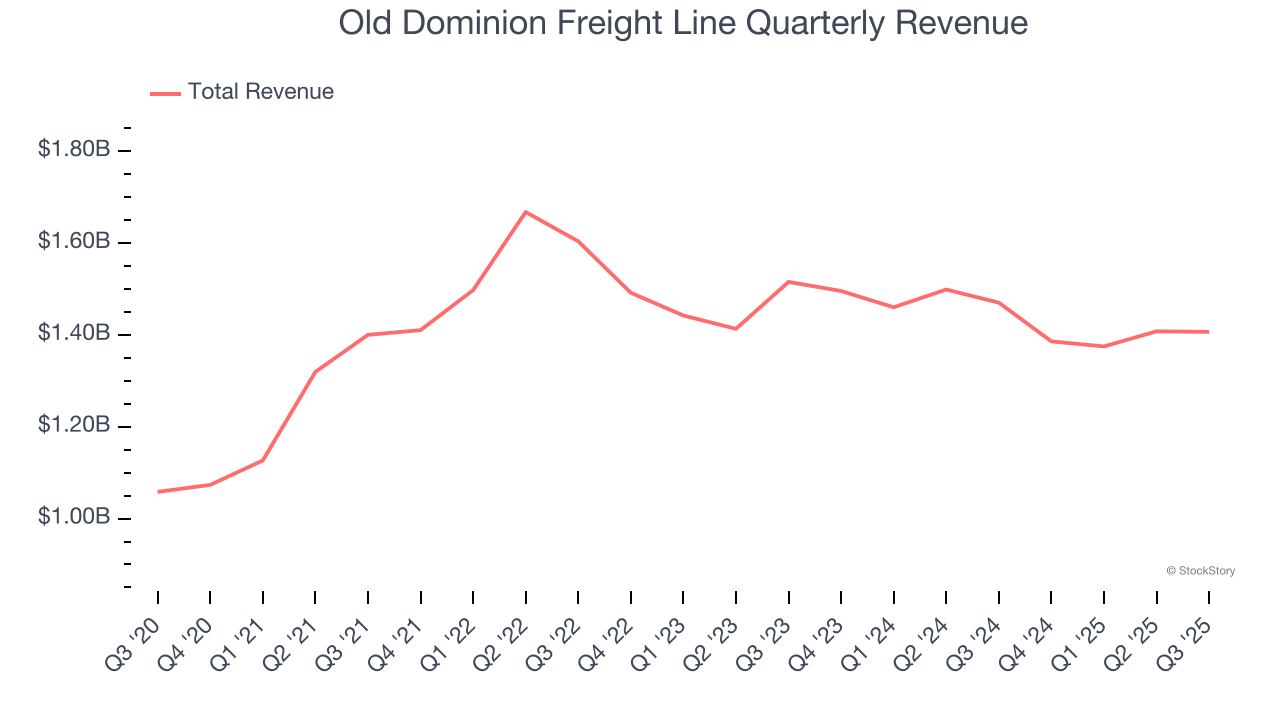
We at StockStory place the most emphasis on long-term growth, but within industrials, a half-decade historical view may miss cycles, industry trends, or a company capitalizing on catalysts such as a new contract win or a successful product line. Old Dominion Freight Line’s performance shows it grew in the past but relinquished its gains over the last two years, as its revenue fell by 2.5% annually. Old Dominion Freight Line isn’t alone in its struggles as the Ground Transportation industry experienced a cyclical downturn, with many similar businesses observing lower sales at this time. 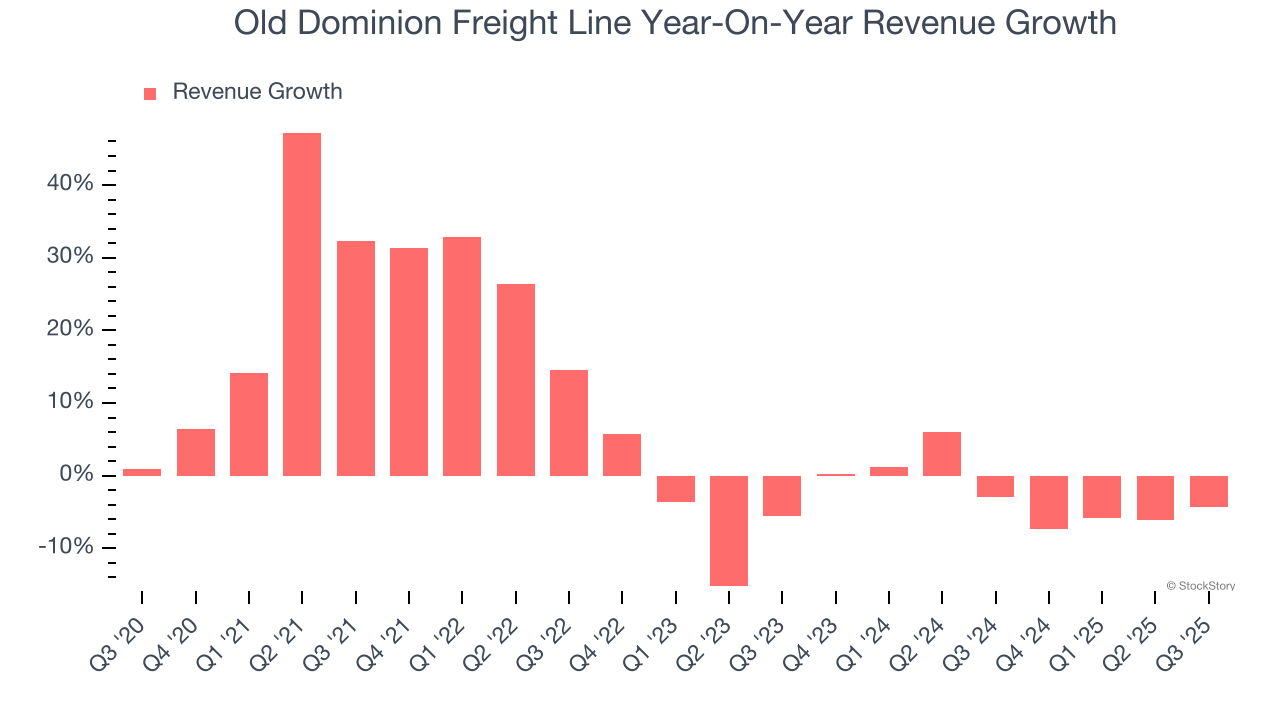
Old Dominion Freight Line also reports its number of units sold, which reached 2.83 million in the latest quarter. Over the last two years, Old Dominion Freight Line’s units sold averaged 3.2% year-on-year declines. Because this number is in line with its revenue growth, we can see the company kept its prices fairly consistent. 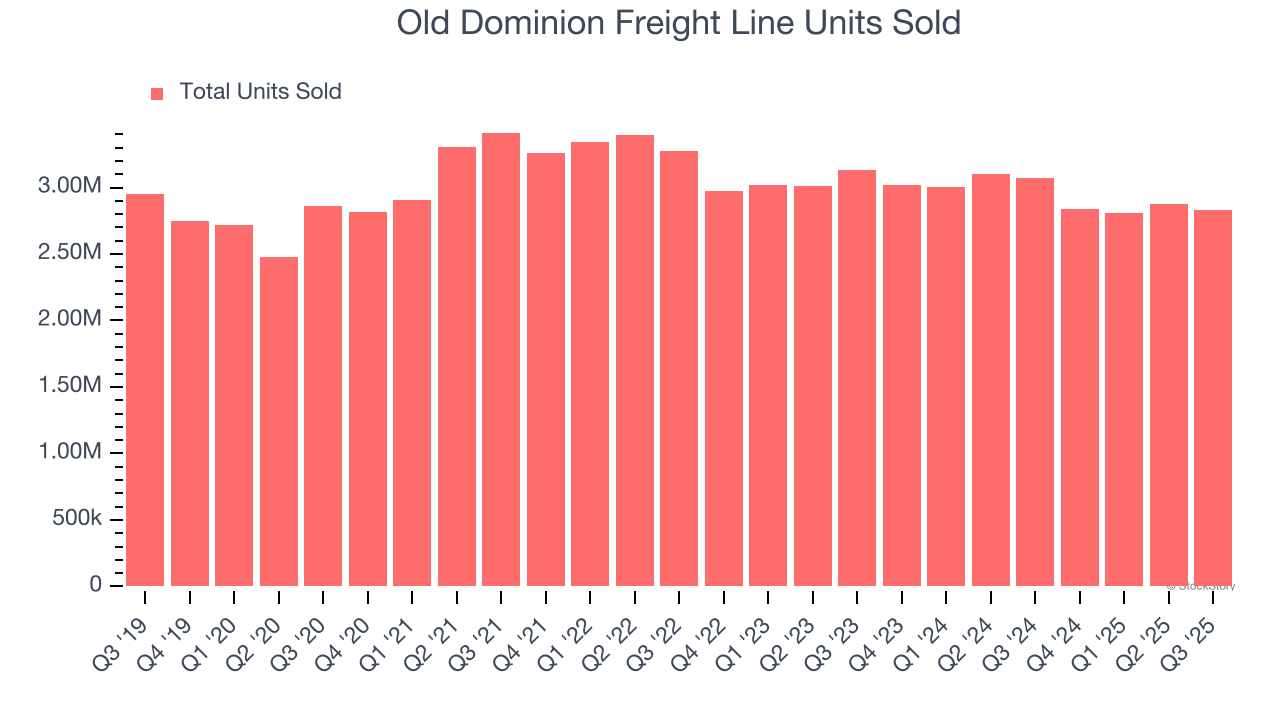
This quarter, Old Dominion Freight Line reported a rather uninspiring 4.3% year-on-year revenue decline to $1.41 billion of revenue, in line with Wall Street’s estimates.
Looking ahead, sell-side analysts expect revenue to grow 2.9% over the next 12 months. Although this projection suggests its newer products and services will fuel better top-line performance, it is still below the sector average.
Software is eating the world and there is virtually no industry left that has been untouched by it. That drives increasing demand for tools helping software developers do their jobs, whether it be monitoring critical cloud infrastructure, integrating audio and video functionality, or ensuring smooth content streaming. Click here to access a free report on our 3 favorite stocks to play this generational megatrend.
Operating Margin
Old Dominion Freight Line’s operating margin might fluctuated slightly over the last 12 months but has remained more or less the same, averaging 27.1% over the last five years. This profitability was elite for an industrials business thanks to its efficient cost structure and economies of scale. This result isn’t surprising as its high gross margin gives it a favorable starting point.
Looking at the trend in its profitability, Old Dominion Freight Line’s operating margin might fluctuated slightly but has generally stayed the same over the last five years. We like to see margin expansion, but we’re still happy with Old Dominion Freight Line’s performance, especially when considering the cycle turned in the wrong direction and most peers observed plummeting revenue and margins.
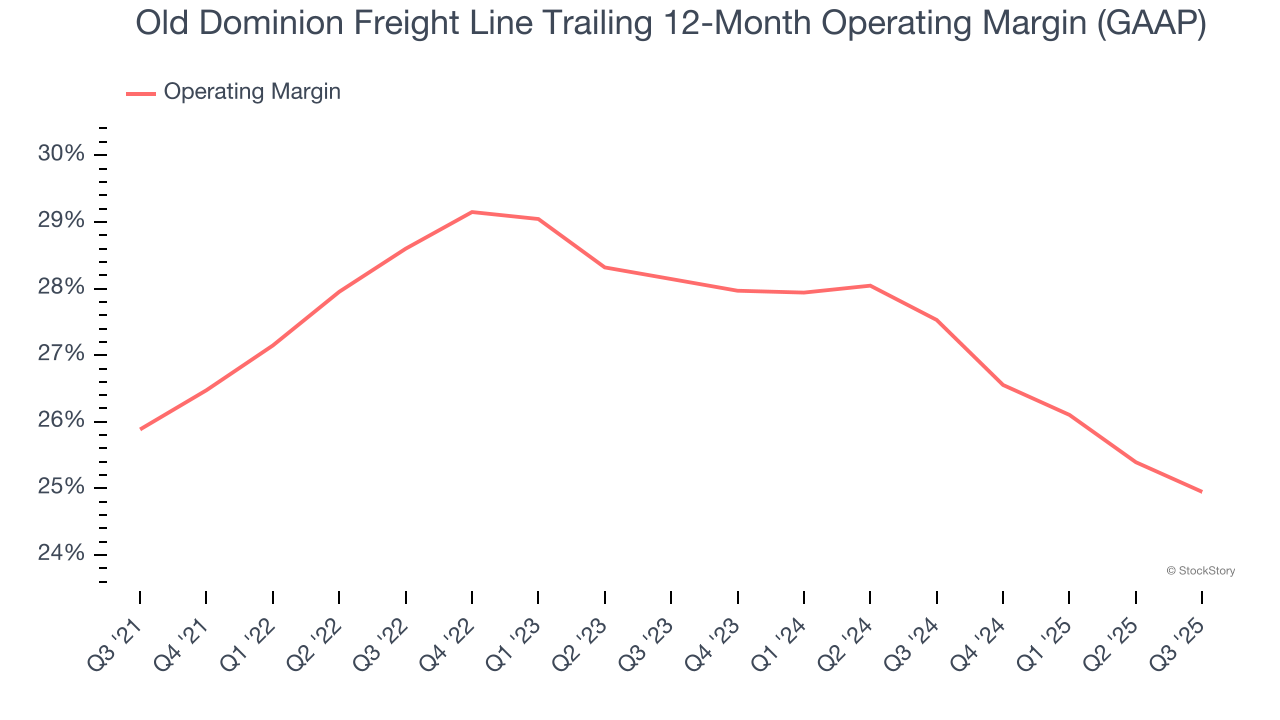
This quarter, Old Dominion Freight Line generated an operating margin profit margin of 25.7%, down 1.7 percentage points year on year. Since Old Dominion Freight Line’s operating margin decreased more than its gross margin, we can assume it was less efficient because expenses such as marketing, R&D, and administrative overhead increased.
Earnings Per Share
Revenue trends explain a company’s historical growth, but the long-term change in earnings per share (EPS) points to the profitability of that growth – for example, a company could inflate its sales through excessive spending on advertising and promotions.
Old Dominion Freight Line’s EPS grew at a remarkable 13.5% compounded annual growth rate over the last five years, higher than its 7.1% annualized revenue growth. However, this alone doesn’t tell us much about its business quality because its operating margin didn’t improve.
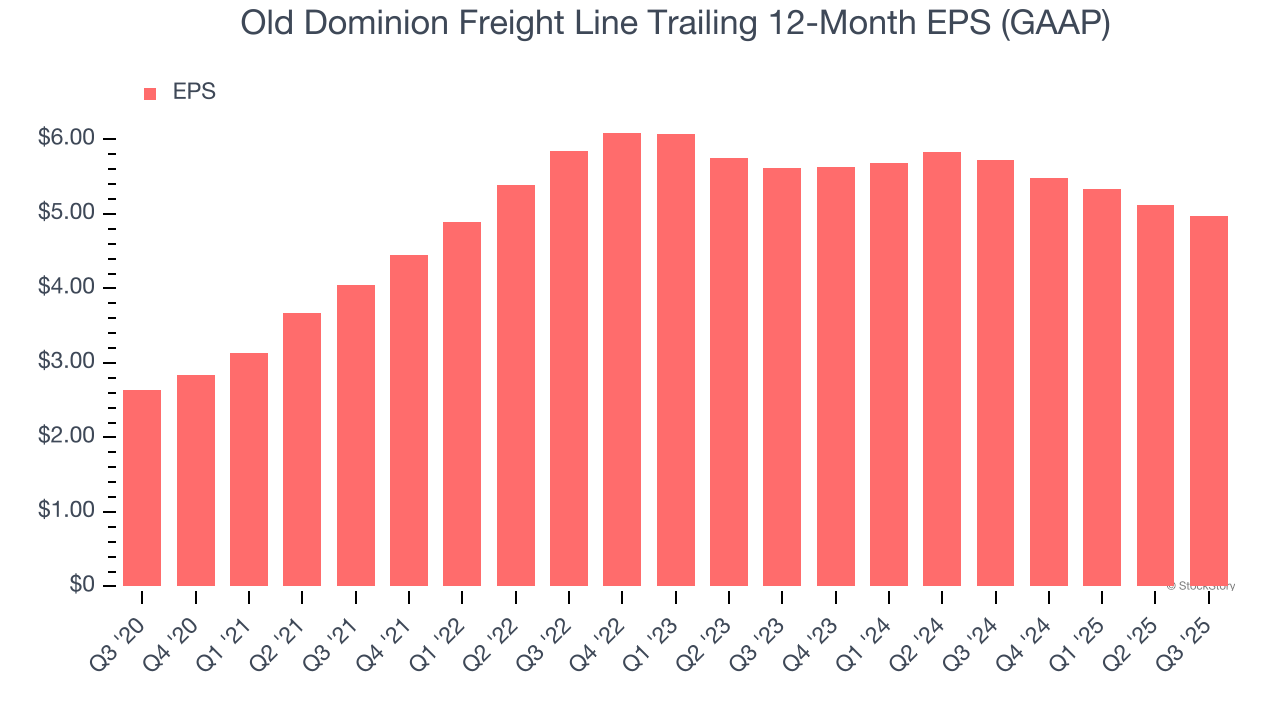
We can take a deeper look into Old Dominion Freight Line’s earnings quality to better understand the drivers of its performance. A five-year view shows that Old Dominion Freight Line has repurchased its stock, shrinking its share count by 10.6%. This tells us its EPS outperformed its revenue not because of increased operational efficiency but financial engineering, as buybacks boost per share earnings. 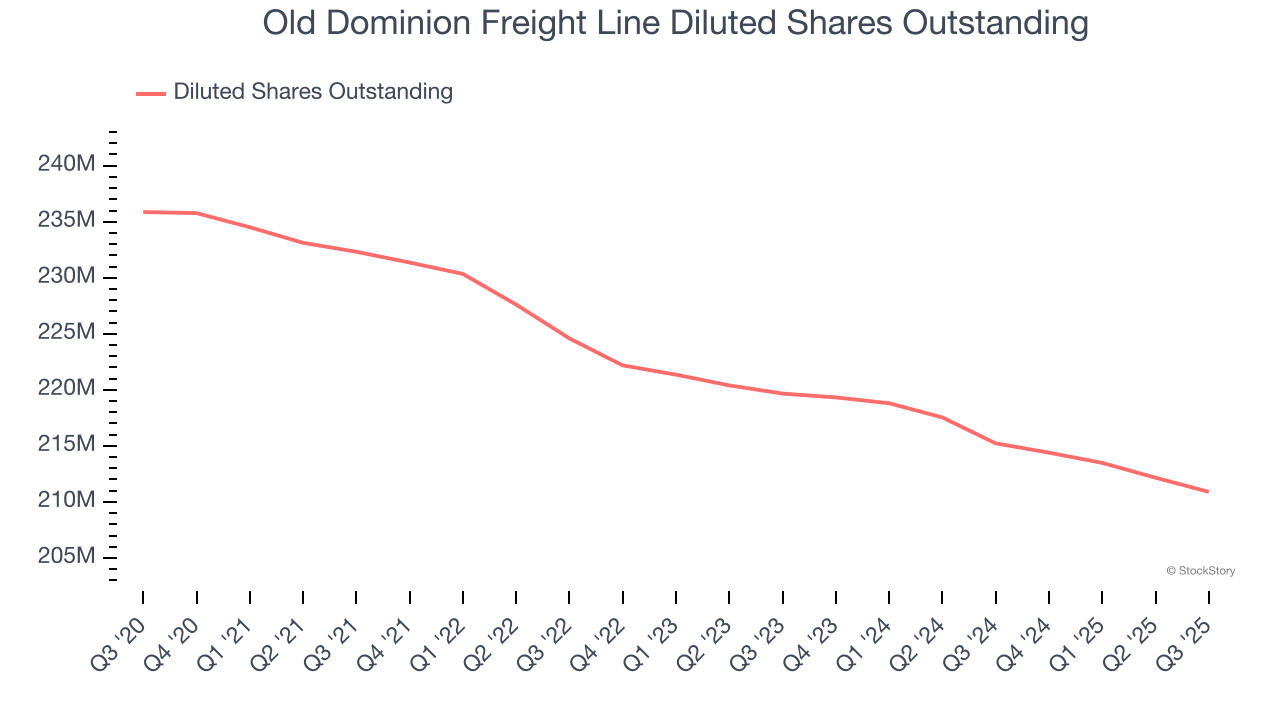
Like with revenue, we analyze EPS over a more recent period because it can provide insight into an emerging theme or development for the business.
For Old Dominion Freight Line, its two-year annual EPS declines of 6% mark a reversal from its (seemingly) healthy five-year trend. We hope Old Dominion Freight Line can return to earnings growth in the future.
In Q3, Old Dominion Freight Line reported EPS of $1.28, down from $1.43 in the same quarter last year. Despite falling year on year, this print beat analysts’ estimates by 5.2%. Over the next 12 months, Wall Street expects Old Dominion Freight Line’s full-year EPS of $4.97 to grow 2.3%.
Key Takeaways from Old Dominion Freight Line’s Q3 Results
We enjoyed seeing Old Dominion Freight Line beat analysts’ EBITDA expectations this quarter. We were also glad its EPS outperformed Wall Street’s estimates. Overall, we think this was a solid quarter with some key areas of upside. The stock traded up 4.8% to $142.51 immediately following the results.
Old Dominion Freight Line put up rock-solid earnings, but one quarter doesn’t necessarily make the stock a buy. Let’s see if this is a good investment. We think that the latest quarter is only one piece of the longer-term business quality puzzle. Quality, when combined with valuation, can help determine if the stock is a buy. We cover that in our actionable full research report which you can read here, it’s free for active Edge members.





